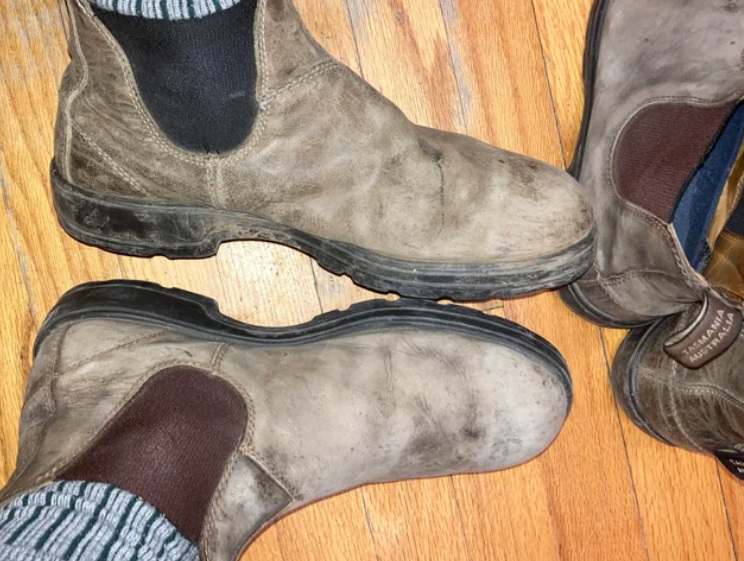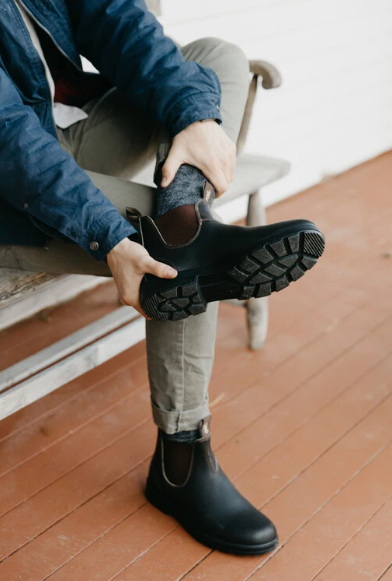Content Menu
● Understanding Chelsea Boots
>> Why Are Chelsea Boots Hard to Remove?
● Methods for Removing Chelsea Boots
>> 1. The Traditional Hand Pull Method
>> 2. Using a Boot Jack
>> 3. The Shoehorn Technique
>> 4. The "Kick-Off" Method (Use with Caution)
>> 5. The Insole Removal Trick
>> 6. The Sock Adjustment Method
● Tips for Easier Removal
>> 1. Break-In Your Boots
>> 2. Use Thick Socks
>> 3. Keep Your Feet Dry
>> 4. Stretch the Boots
>> 5. Heat Treatment
● Shoe Care During the Break-In Process
>> Cleaning
>> Conditioning
>> Protection
● Conclusion
● FAQ
>> 1. Why are my new Chelsea boots so hard to get off?
>> 2. Can I damage my Chelsea boots by pulling them off too hard?
>> 3. How often should I condition my Chelsea boots?
>> 4. Is it okay to use a hair dryer to stretch my Chelsea boots?
>> 5. What is the best way to store my Chelsea boots?
● Citations:
Chelsea boots are a stylish and versatile footwear choice, loved for their sleek design and comfortable fit. However, anyone who has owned a pair knows that sometimes taking them off can be a bit of a struggle. This comprehensive guide provides various methods and tips on how to remove Chelsea boots with ease, ensuring you don't damage the boots or injure yourself in the process.

Understanding Chelsea Boots
Chelsea boots are characterized by their elastic side panels, close-fitting ankle, and minimalist design. They originated in the Victorian era and have since become a fashion staple for both men and women. The snug fit around the ankle, which contributes to their stylish look, can also make them difficult to remove[8].
Why Are Chelsea Boots Hard to Remove?
Several factors contribute to the difficulty of removing Chelsea boots:
- Snug Fit: Chelsea boots are designed to fit snugly around the ankle to maintain a streamlined silhouette. This close fit can create friction when trying to pull the boots off.
- New Leather: New Chelsea boots, especially those made from stiff leather, can be particularly challenging to remove. The leather needs time to soften and stretch to conform to the shape of your foot[6].
- Lack of Laces: Unlike lace-up boots, Chelsea boots lack a lacing system that can be loosened to create more room for removal.
- Sweaty Feet: Perspiration can cause your feet to stick to the inside of the boots, increasing friction and making them harder to pull off.
Methods for Removing Chelsea Boots
1. The Traditional Hand Pull Method
The most common method for removing Chelsea boots involves using your hands to grip the boot and pull it off your foot. Here's how to do it effectively:
1. Sit Down: Find a comfortable place to sit. This provides stability and leverage.
2. Grip the Boot: Hold the back of your ankle with one hand and grab the toe with the other hand[1].
3. Pull and Wiggle: Gently pull the boot while wiggling your foot. Alternate between pulling and wiggling to gradually ease the boot off your heel.
4. Repeat: Repeat the process until the boot is completely removed.
2. Using a Boot Jack
A boot jack is a handy tool designed specifically for removing boots. It minimizes the effort and potential damage to the boots[3].
1. Position the Boot Jack: Place the boot jack on the floor with the U-shaped opening facing away from you[3].
2. Place Your Foot: Put your non-booted foot on the flat end of the boot jack to hold it in place[3].
3. Insert Heel: Slide the heel of your booted foot into the U-shaped opening[3].
4. Pull Out: Pull your foot out of the boot while the boot jack holds the boot securely[3].
5. Repeat: Repeat with the other foot.
3. The Shoehorn Technique
A shoehorn can also assist in removing Chelsea boots by reducing friction between your heel and the boot[1].
1. Insert Shoehorn: Slide the shoehorn between your heel and the back of the boot[1].
2. Wiggle Foot: Wiggle your foot while holding the shoehorn in place.
3. Pull Off: Gently pull the boot off, using the shoehorn to guide your heel[1].
4. The "Kick-Off" Method (Use with Caution)
Some people resort to kicking off their Chelsea boots, but this method can damage the boots if not done carefully[1].
1. Sit or Stand: Find a stable position, either sitting or standing.
2. Position Heel: Use the opposite foot to push down on the heel of the boot you want to remove[1].
3. Kick Forward: Simultaneously kick your foot forward while pushing down on the heel of the boot.
4. Control Force: Use minimal force to avoid damaging the boot's sole or heel.
Warning: This method is not recommended for expensive or delicate Chelsea boots.
5. The Insole Removal Trick
Removing the insole can create a bit more space inside the boot, making it easier to slide your foot out[1].
1. Remove Insole: Carefully take out the insole from the boot.
2. Try Again: Attempt to remove the boot using one of the methods described above.
3. Replace Insole: Once the boot is off, replace the insole for regular wear.
6. The Sock Adjustment Method
Sometimes, the issue isn't the boot itself, but the socks you're wearing.
1. Adjust Socks: Make sure your socks are not bunched up around your toes or heel.
2. Smooth Out: Smooth out any wrinkles or folds in your socks to reduce friction.
3. Try Again: Attempt to remove the boot using one of the methods described above.

Tips for Easier Removal
1. Break-In Your Boots
New Chelsea boots often require a break-in period. The more you wear them, the more the leather will soften and mold to your feet, making them easier to remove[4].
- Wear Them Regularly: Wear your Chelsea boots for short periods initially, gradually increasing the wear time[10].
- Use a Leather Conditioner: Apply a leather conditioner to soften the leather and make it more pliable[5].
- Massage the Heel: Gently massage the heel part of the boots with your hands to help break them in[4].
2. Use Thick Socks
Wearing thick socks can provide cushioning and reduce friction, making it easier to slide your feet in and out of the boots[7].
- Cushioning: Thick socks add a layer of padding that can prevent rubbing and blisters[7].
- Reduced Friction: The extra layer can help your feet slide more easily in and out of the boots.
3. Keep Your Feet Dry
Moisture can cause your feet to stick to the inside of the boots.
- Use Foot Powder: Apply foot powder to absorb moisture and reduce friction.
- Wear Breathable Socks: Opt for socks made from breathable materials like cotton or wool.
4. Stretch the Boots
If your Chelsea boots are particularly tight, consider stretching them[9].
- Shoe Stretcher: Use a shoe stretcher to widen the boots[7].
- Leather Stretching Spray: Apply a leather stretching spray to the tight areas of the boots before wearing them[9].
- Professional Stretching: Take your boots to a cobbler for professional stretching[2].
5. Heat Treatment
Applying heat can make the leather more pliable, but this method should be used cautiously[6].
- Use a Hair Dryer: While wearing thick socks, use a hair dryer to gently heat the tight areas of the boots for about 20 seconds[10].
- Wear and Cool: Keep the boots on until the leather cools to allow it to mold to your feet[10].
Caution: Avoid overheating the leather, as this can cause damage.
Shoe Care During the Break-In Process
Taking care of your Chelsea boots during the break-in period is essential to maintain their quality and appearance[6].
Cleaning
- Regular Cleaning: Clean your boots regularly with a soft cloth or leather cleaner[5].
- Remove Dirt: Use a brush to remove dirt and debris from the surface of the boots[2].
- Canvas Cleaning: Clean any patches of dirt in warm soapy water with a soft-bristled brush or soft cloth[2].
Conditioning
- Leather Conditioner: Apply a leather conditioner to prevent the leather from drying out and cracking[5].
- Wonder Balsam: Use Dr. Martens' Wonder Balsam to nourish and soften the leather[6].
Protection
- Waterproof Spray: Use a waterproof spray to protect your boots from moisture and stains[5].
- Avoid Heat: Do not dry your boots by an open fire or artificial heat source, as this can cause the leather to harden and shrink[2].
Conclusion
Removing Chelsea boots can be a challenge, especially when they are new. However, by using the right techniques and tools, you can make the process easier and prevent damage to your boots. Whether you prefer the traditional hand pull method, a boot jack, or a shoehorn, there's a solution for everyone. Remember to break in your boots properly, keep your feet dry, and care for the leather to ensure your Chelsea boots remain a stylish and comfortable part of your wardrobe for years to come.

FAQ
1. Why are my new Chelsea boots so hard to get off?
New Chelsea boots are typically made from stiff leather that hasn't yet molded to the shape of your foot. This stiffness, combined with the snug fit around the ankle, makes them difficult to remove. Over time, the leather will soften and stretch, making the boots easier to take off[6].
2. Can I damage my Chelsea boots by pulling them off too hard?
Yes, excessive force can damage your Chelsea boots. Pulling too hard can stress the seams, elastic panels, and the connection between the sole and the upper. It's best to use gentle, controlled movements and辅助tools like a boot jack or shoehorn[3].
3. How often should I condition my Chelsea boots?
You should condition your Chelsea boots every few months, or whenever the leather starts to feel dry. Regular conditioning helps to keep the leather soft and supple, preventing cracks and extending the life of your boots[5].
4. Is it okay to use a hair dryer to stretch my Chelsea boots?
Using a hair dryer can help to soften the leather and make it more pliable, but it should be done with caution. Use a low heat setting and avoid holding the hair dryer too close to the leather, as excessive heat can cause damage. Wear thick socks while heating the boots to help them mold to your feet[10].
5. What is the best way to store my Chelsea boots?
Store your Chelsea boots in a cool, well-ventilated place away from direct sunlight and heat. Use shoe trees to help maintain their shape and prevent creases. Avoid storing them in plastic bags, as this can trap moisture and lead to mold growth[2].
Citations:
[1] https://www.reddit.com/r/BlundstoneBoots/comments/1cge1to/can_we_talk_about_how_hard_these_boots_are_to_get/
[2] https://chelseabootstore.com/shoe-care-guide/
[3] https://chelseabootstore.com/what-is-a-boot-jack/
[4] https://www.blundstone.com/how-do-you-break-in-new-boots
[5] https://nicksboots.com/blog/post/chelsea-work-boots/
[6] https://nushoe.com/break-in-dr-martens-chelsea-boots/
[7] https://chelseabootstore.com/how-to-break-in-your-chelsea-boots/
[8] https://www.youtube.com/watch?v=MiH9aXMYCnA
[9] https://bakershoe.com/blogs/news/how-to-stretch-and-soften-leather-boots
[10] https://www.timberland.co.uk/en-gb/customer-care/product-faqs/how-to-stretch-and-soften-leather-footwear
[11] https://www.youtube.com/watch?v=SOcwD5_2k1U
[12] https://www.acemarks.com/blogs/magazine/chelsea-boots-ultimate-guide
[13] https://www.reddit.com/r/BlundstoneBoots/comments/16n17zt/new_chelsea_boots_cutting_off_circulation/
[14] https://www.ahume.co.uk/blog/chelsea-boots-the-ultimate-buyers-guide/
[15] https://www.youtube.com/watch?v=T8idG4nxeTM
[16] https://stridewise.com/boots-too-big/
[17] https://www.yelp.com/questions/shoe-cobbler-the-elastic-on-my-chelsea-boots-have-ripped-a-bit-is-it-possible-to-get-the-elastic/WVUB9esHKQGaKKaopp0Miw
[18] https://www.oswinhyde.com/blogs/news/caring-for-your-chelsea-boots-tips-to-maintain-their-elegance
[19] https://www.instagram.com/leshoeguy/reel/Cn98zeWj5L2/?hl=en
[20] https://www.joserealshoes.com/blogs/noticias/the-ultimate-guide-to-chelsea-boots-everything-you-need-to-know
[21] https://www.tiktok.com/discover/taking-off-doc-martens-chelsea-boots
[22] https://trimly.com.au/blogs/trimlymusings/sticky-boot-trees
[23] https://www.youtube.com/watch?v=LKQ-YqwmSsI
[24] https://www.youtube.com/watch?v=4CljmNgK0TU
[25] https://www.facebook.com/brittanynbros/videos/how-to-use-the-blundstone-boot-jack-this-thing-will-save-your-back-grab-your-tod/4722257901179299/
[26] https://www.youtube.com/watch?v=cCyru8__-64
[27] https://www.panamajack.nl/blogs/news/how-to-clean-chelsea-boots
[28] https://www.tiktok.com/discover/how-to-break-in-chelsea-boots
[29] https://www.drmartens.com/us/en/guides/how-to-break-in-docs
[30] https://www.youtube.com/watch?v=R37v_lIYFO0
[31] https://www.isabelbernard.com/collections/chelsea-boots
[32] https://hhplace.org/topic/22722-trick-to-put-on-tight-fitting-pull-on-boots/
[33] https://castboolits.gunloads.com/archive/index.php/t-289301.html
[34] https://www.reddit.com/r/goodyearwelt/comments/3qkcru/could_somebody_explain_chelsea_boots_for_me/
[35] https://www.reddit.com/r/Boots/comments/1fwriqm/help_removing_staindiscoloration_on_cheap_chelsea/
[36] https://www.chelseaboot.com/pages/faqs
[37] https://saddlehunter.com/community/index.php
[38] https://www.youtube.com/watch?v=40CyncMmZkc
[39] https://shoerepairer.info/topic/13319-chelsea-boot-help/
[40] https://www.badgerandblade.com/forum/threads/rm-williams-chelsea-boots.649976/
[41] https://www.beckettsimonon.com/blogs/resources/common-problems-with-men-s-shoes
[42] https://skimo.co/solve-ski-bootfitting-problems
[43] https://www.youtube.com/watch?v=iYFhECl-xNM
[44] https://www.youtube.com/watch?v=hT61uZL0gVY
[45] https://www.vionicshoes.com/blog/what-are-chelsea-boots/

















